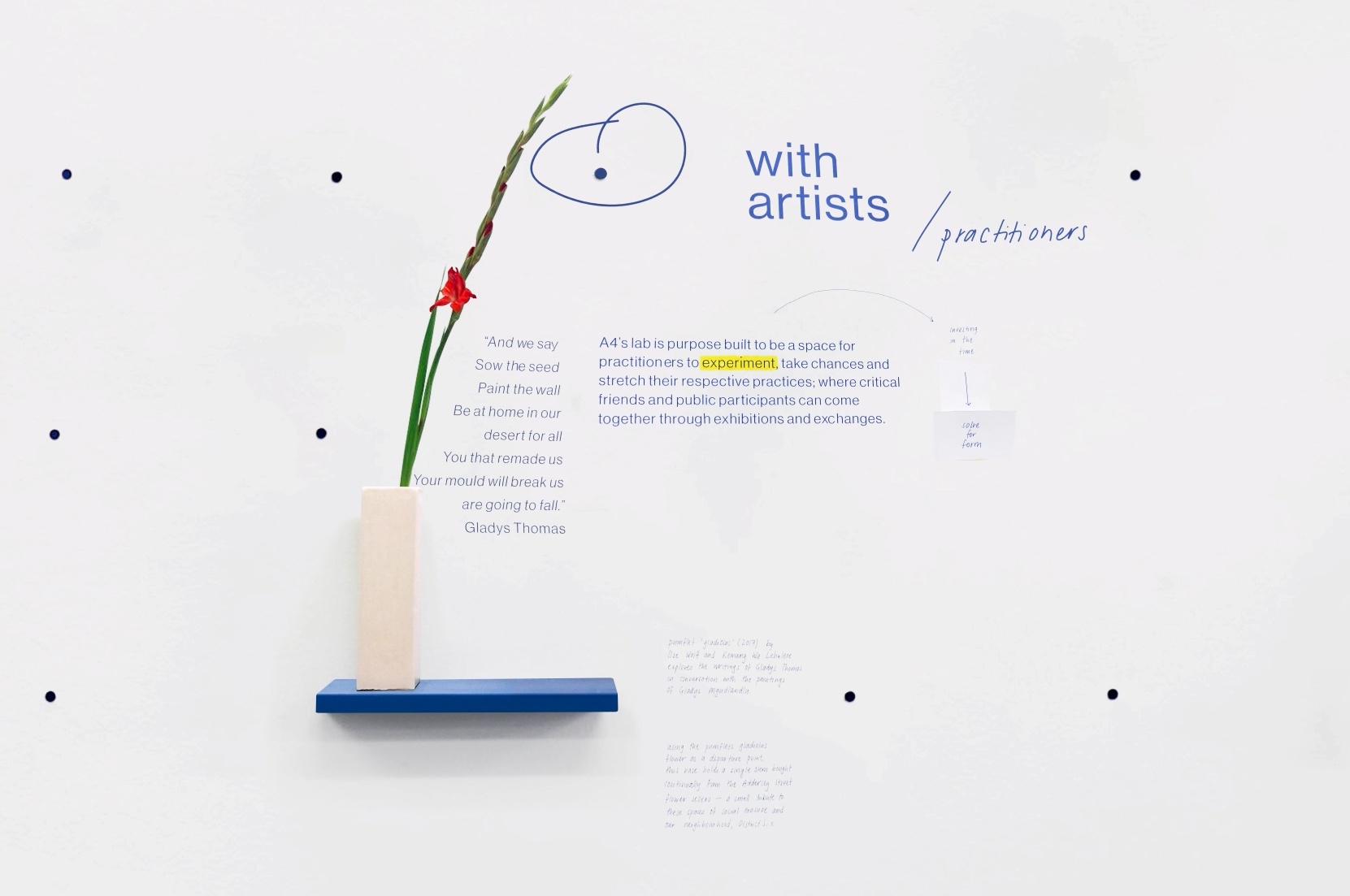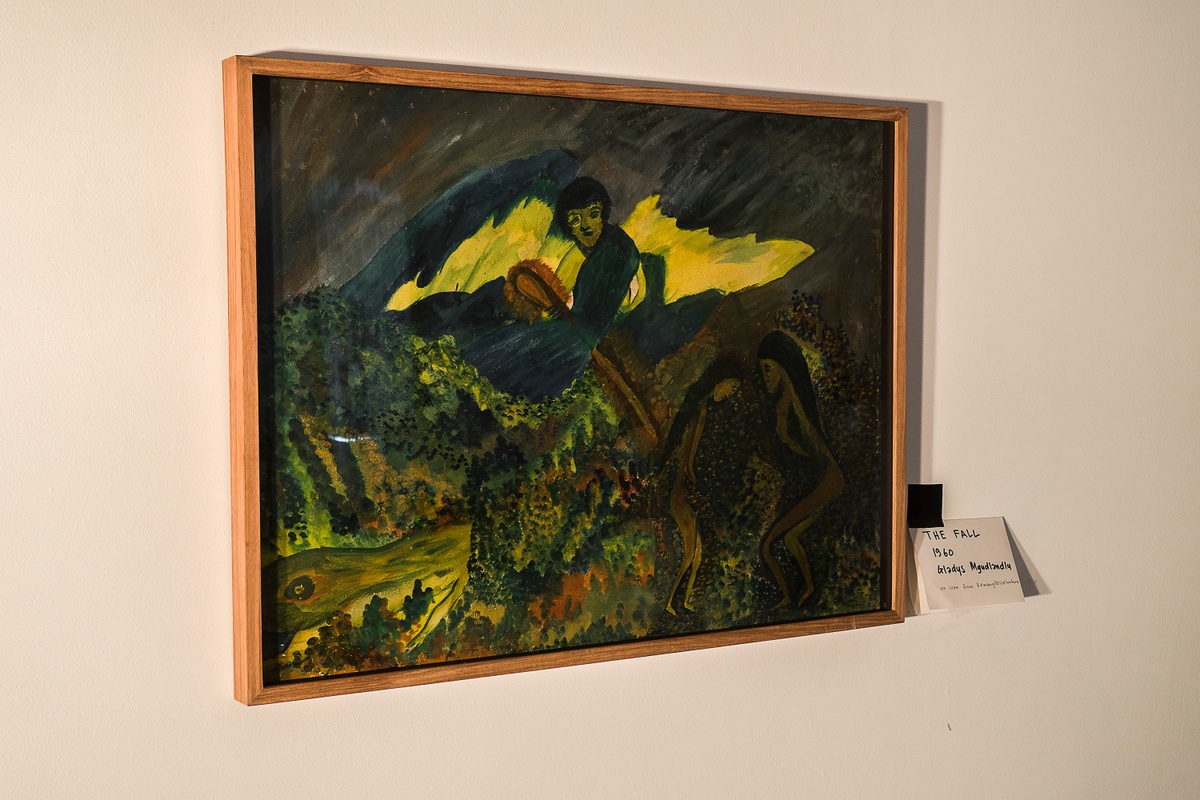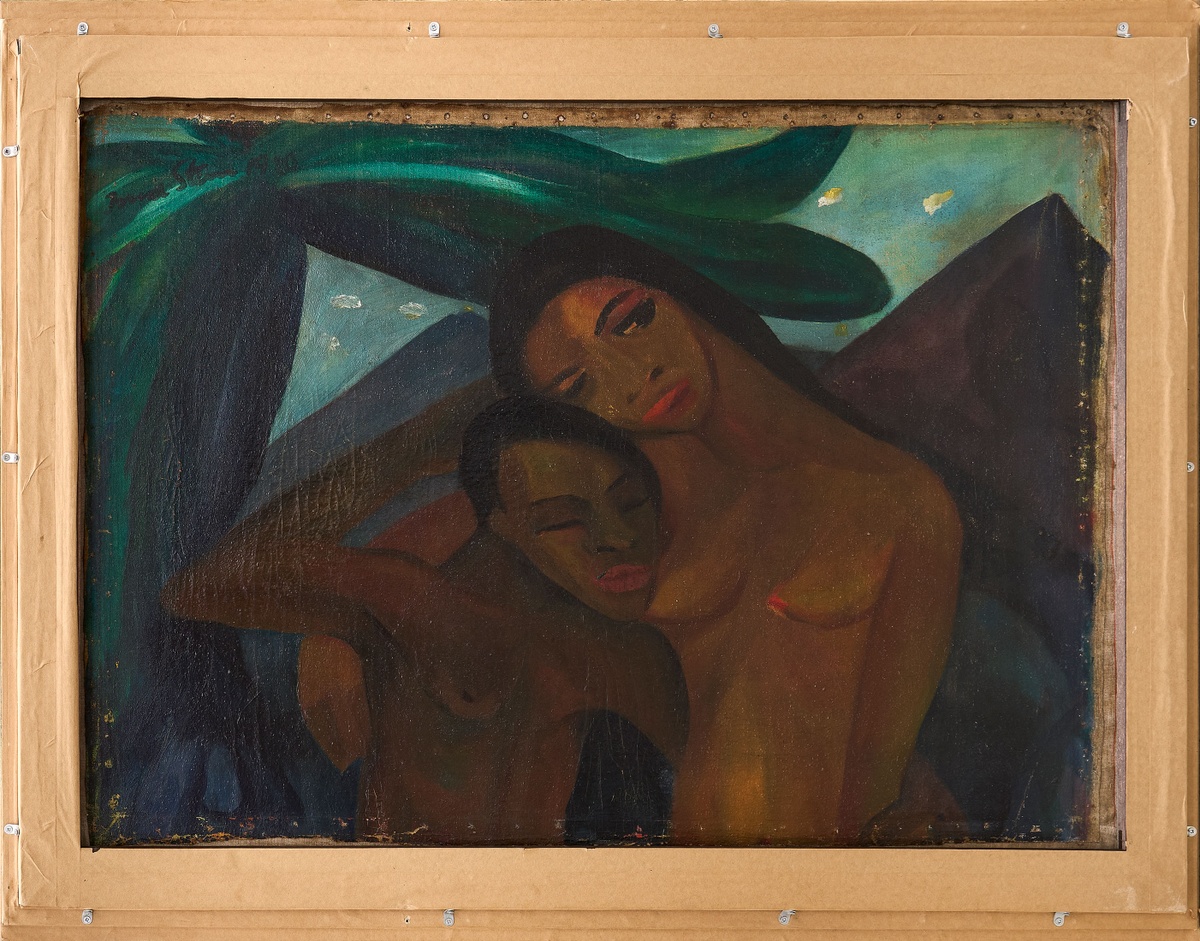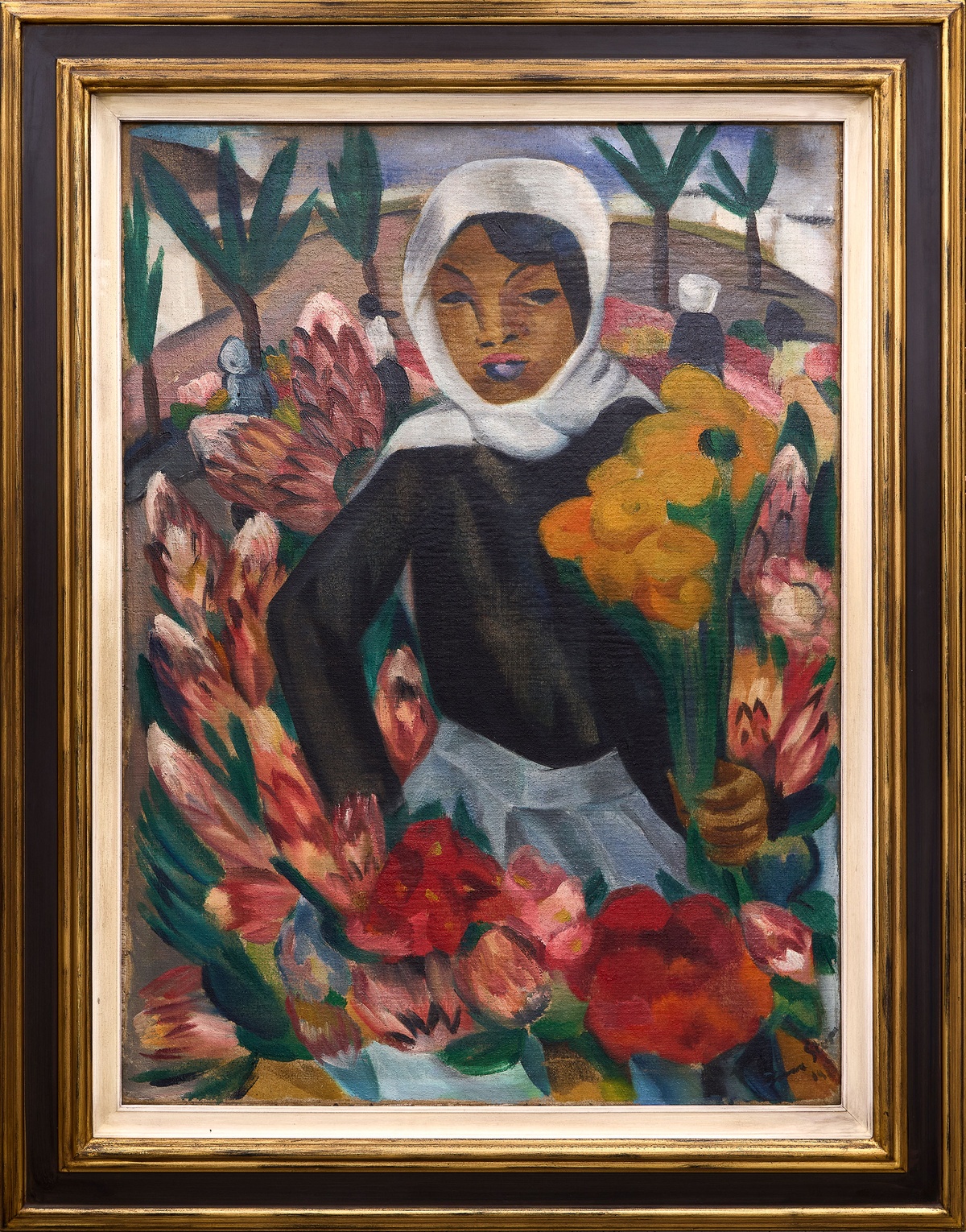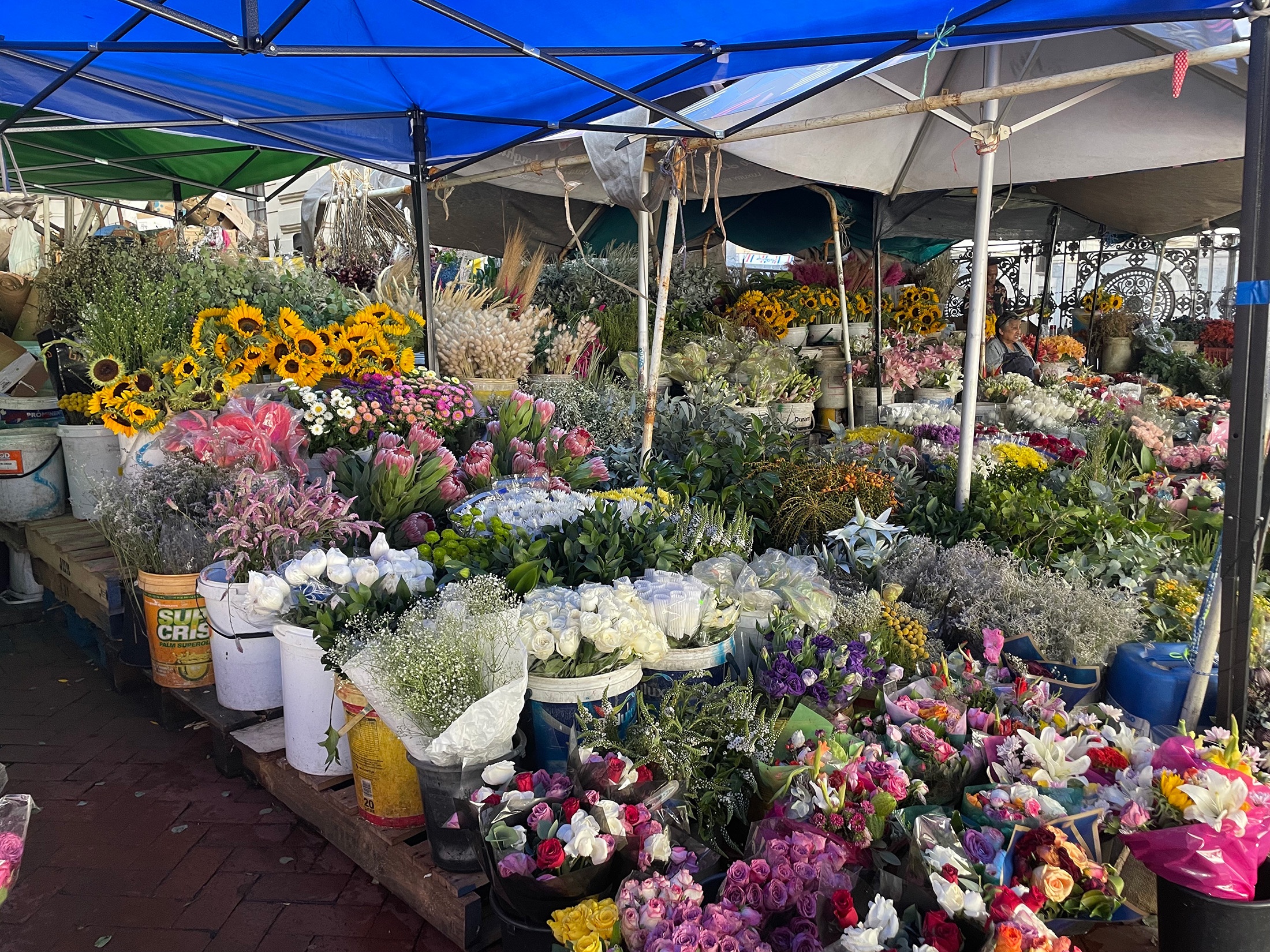On A4’s About Wall, a gladiolus stem sourced from Adderley Street flower market sits in a vase alongside an excerpt from a poem, Fall Tomorrow by Gladys Thomas (b.1935; d.2022). The poem formed part of an anthology published in 1972, Cry Rage, which was the first book of poetry that was banned by the apartheid government.
And we say
Sow the seed
Paint the wall
Be at home in our
desert for all
You that remade us
Your mould will break us
And tomorrow you are going to fall.
In 2017, Thomas’s words were featured in Pumflet Gladiolus in conversation with the paintings of Gladys Mgudlandlu (b.1925; d.1979) – an enquiry led by artist Kemang Wa Lehulere and architect Ilze Wolff. The publication works through feelings of anger, melancholia, impatience and nostalgia in light of the scars of the forced removals. This action came from the Group Areas Act, a systemised segregation of land, passed in 1950 and led to the destruction of various diverse neighbourhoods over the next decades – one being District 6 in Central Cape Town, where A4 is located. The flower in A4’s About Wall is a delicate, but sharp echo of resistance against social erasure.
As part of the presentation of Pumflet Gladiolus at A4 in 2017/18, Wa Lehulere and Wolff displayed Gladys Mgudlandlu's painting The Fall (1960). It depicts the expulsion of Adam and Eve from the Garden of Eden in quickfire brushstrokes and a dream-like quality. In tense anticipation of how the Group Areas Act would be deployed in the decade after this painting, it was no coincidence that Mgudlandlu was drawn to the subject matter of two people huddling together for safety in the open landscape as a fierce presence sought to drive them from their home.
The visual language in The Fall transports my mind to another artwork at another point in time – Irma Stern in 1920. Appearing on the reverse of another painting that has come into A4’s custodianship temporarily, Stern depicts a similar scene in an untitled work: a painting of a woman and a boy finding comfort under a palm tree in an ambiguous mountainous landscape. The concealed work is dated 1920 in the top-left corner, which gives a sense of how soon Stern began painting after she arrived in Cape Town in the same year, with Berlin’s influence still strong at hand. At this time, her subject matter largely consisted of these wild landscapes, floral arrangements, and exoticised portraits of indigenous, black and Cape Malay figures – drawing connections between her specific conception of Africa, its land and its people.
Differing from the formal qualities of Stern’s later years, the paintings’ style references the primitivist-expressionist compositions of her mentor in Berlin, Max Pechstein, who painted his subjects as angular, outlined nudes after visiting the Palau archipelago in the Pacific Ocean, as well as the Baltic coast along the North Sea1. The geometrical, flat quality can be seen as an early gesture to locate her style as a young artist, with the idealisation of ‘native’ scenes existing at the forefront of her practice.
The work onto which this Eden-like expression is attached is Cape Flower Seller (c.1922): a portrait of Armina Brenner (b.1902), one of the matriarchs of the Adderley Street market, bringing us back to the 150-year-old flower dynasty. Armina was one of the five daughters of Hadira Brenner, who was recorded to be the first woman to sell flowers to the shop owners on the busy street, as well as at the Cape Town docks2. The ‘blomraers’ (flower carriers), as they came to be known, were a community of families that established the Cape Town flower market – often travelling long distances to the city centre to sell their goods. The market is still thriving today, with different sellers’ stalls all stemming from Hadira’s bloodline.
In Stern’s painting, Armina emerges from the painterly thicket of protea bundles in the background, holding up the gladiolus in concert with a golden gerbera daisy. It’s as if she is presenting the beginnings of a bouquet to the viewer, or perhaps even warning us with the sword-lily (‘gladiolus’ derives from Latin, the diminutive of ‘gladius’: a sword). Both the protea and the gladiolus have their centre of origin located within the Cape Floristic Region, with the gerbera being native to South Africa at large. This delineates further connection to the message of Pumflet Gladiolus, which utilised the Adderley Street flower market as another publication launch venue in 2017.
When Stern initially returned from Berlin to Cape Town in 1920, a bright memory of her childhood home returned to her while on the boat: “The splendour of its [Africa’s] flowers saturated with colour…”. This recollection created an expectation of what Hadira or the other flower sellers might be carrying upon her arrival at the docks, but instead, she was met with a selection of European flowers instead of an indigenous bouquet. Disappointed, she expressed, “Africa – where was it – where were the free black people – where were the flowers?”3. Cape Flower Seller appears to be Stern’s attempt at answering this question. Africa was located in Brenner’s hands: single stems made up into a vibrant bouquet on Adderley Street.
Stern’s paintings, dated 1920 and c.1922, almost perfectly bookmarked her initial stay in Cape Town. When Stern returned to Berlin in 1923, she took Cape Flower Seller and its reverse counterpart with her, where it then became the property of her cousin, Trude Hernfeld Stern. The First World War pushed Trude to flee from Germany to Brazil in 1939, and it is unclear whether the two paintings were attached before the relocation or on the precipice of it for easier transportation. Another possible theory I might acknowledge here, given the political climate at the time and location, is that Cape Flower Seller may have been framed as the front-facing piece to avoid further inspections from German officials who would have viewed the reverse nude painting as Entartete Kunst and destroyed it.
Entartete Kunst, or ‘Degenerate Art’, was a Nazi cultural campaign launched in Germany in 1937 that targeted fine art that the regime considered racially or ideologically ‘impure’, such as German Expressionism, Cubism, and Dadaism, amongst others. This also included subject matter that was deemed subversive to German nationalist ideals – such as the depiction of nude ‘primitive’ bodies – often created by Jewish, communist, or non-Aryan artists. Although Cape Flower Seller still makes use of a stylised expressionism and features a Muslim woman as the main subject, it may have been the less overtly provocative painting of the two, and Irma, or Trude, could preserve the more politically sensitive artwork at risk while fleeing. The physical act of attachment could have been a form of resistance – a way of protecting art that didn't conform to the regime's racist aesthetic standards.
The paired artworks would spend six decades together on the South American continent before Trude, at 102 years old, and her descendants decided to sell them as a way of returning the works to South Africa. The portrait and its reverse arrived in Cape Town in 2000 and appeared on the catalogue cover of its debut exhibition in South African Paintings 1880 - 2001 at the Irma Stern Museum, curated by Micheal Stevenson and Deon Viljoen. Here, it was acquired and entered a private collection.
The artwork's provenance — including the mysterious attachment of the second canvas and the act of preservation by the smuggling of the work from Germany to Brazil during a time of deep political turmoil — underscores the painting's significance beyond where its formal aesthetics fit within Stern’s stylistic trajectory. Stern opens up her existential questions about Africa and Europe and the intricate ways a painting can preserve and challenge historical narratives.
Cape Flower Seller captures the essence of Adderley Street's historic flower market: the young Armina Brenner in action, making up a vibrant bouquet for the viewer. Through this, the painting manages to reflect Stern's early artistic growth at the turn of the decade, as she developed her style and attempted to reconnect with her home country. The gladiolus flower, appearing both in Stern's early work and later in contemporary responses like Pumflet Gladiolous and A4’s About Wall, serves as a lyrical connection point through time – at once a symbol of indigenous beauty and a flag of resistance.
